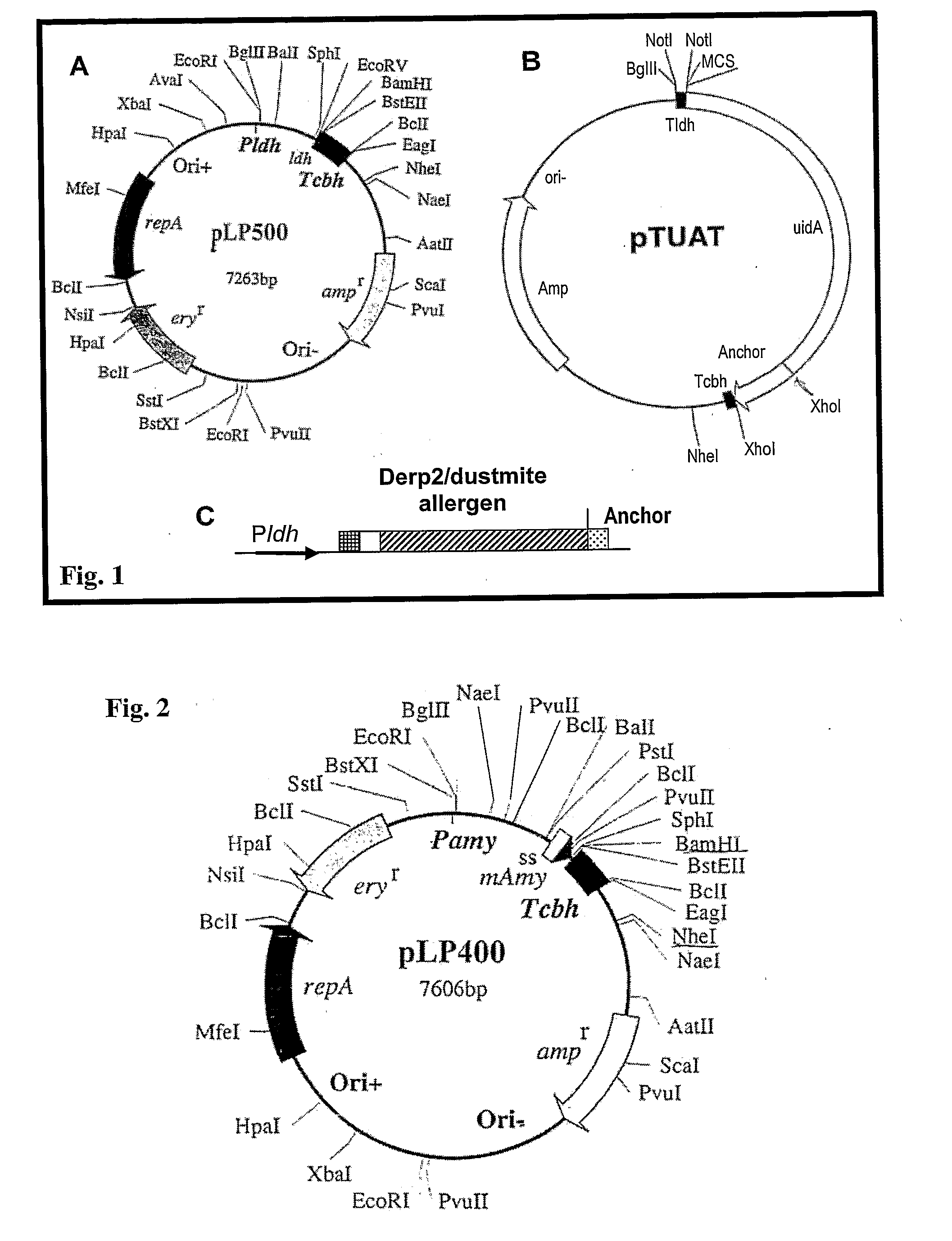Recombinant lactobacillus and use of the same
a technology of lactobacillus and lactobacillus, which is applied in the field of recombinant lactobacillus, can solve the problems of mite allergy, hay fever, runny nose and itchy, etc., and achieve the effects of reducing the risk of mite allergy, and reducing the risk of infection
- Summary
- Abstract
- Description
- Claims
- Application Information
AI Technical Summary
Problems solved by technology
Method used
Image
Examples
example 1
Construction of Recombinant L. Casei Expressing Enhanced Green Fluorescence Protein (eGFP)
[0177]The eGFP gene was amplified by polymerase chain reaction (PCR) using Expand High fidelity DNA polymerease (Boehringer) and synthetic primers BamHI-eGFP / f [5′-CCC CCG GATi CCA gtg agc aag ggc gag gag ctg-3′, SEQ ID NO: 3] and eGFP-xhoSac / r [5′-CCC CCC ctc gag CTT GTA CAG CTC GTC CAT GCC GAG-3′, SEQ ID NO: 4]. The resultant PCR kits containing a Bam HI site at the 5′ end and a Xho I / Sac I site at the 3′ end was subsequently subcloned into the Bam HI and Sac I site of pTUAT (cf. FIG. 1). The Bam HI / Nhe I fragment containing eGFP-uidA-Thch was exchanged with the Bam HI / Nhe I fragment expression-secretion vectors of the pLP500 (cf. FIG. 1).
[0178]The uidA gene was then removed by digestion with Xho I, resulting in the expression construct pLP500-eGFP.
example 2
Cloning of Der P2 Gene and Blo t 5 Gene into Lactobacillus / E. Coli Shuttle Vector
[0179]A 441 bp fragment of Der p2 cDNA was amplified by PCR using Expand High fidelity DNA polymerase (Boehringer) and synthetic primers, Dp2Bam / f [5′-CCCCCGGATCCAGATCAAGTCGATGTCAAAGATTGTGC-3′, SEQ ID NO: 5] and Dp2xhoSac / r [5′-CCCCCCGAGCTCCTCGAGATCGCGGATTTTAGCATGAGTAGC-3′, SEQ ID NO: 6]. The resultant PCR kit of the Der p 2 gene containing a Bam HI and a Xho I / Sac I site, at the 5′- and 3′-end respectively, had the sequence: 5′-GGATCC A GAT CAA GTC GAT GTC AAA GAT TGT GCC AAT CAT GAA ATC AAA AAA GTT TTG GTA CCA GGA TGC CAT GGT TCA GAA CCA TGT ATC ATT CAT CGT GGT AAA CCA TTC CAA TTG GAA GCC GTT TTC GAA GCC AAC CAA AAC ACA AAA ACC GCT AAA ATT GAA ATC AAA GCC TCA ATC GAT GGT TTA GAA GTT GAT GTT CCC CGT ATC GAT CCA AAT GCA TGC CAT TAC ATG AAA TGC CCA TTG GTT AAA GGA CAA CAA TAT GAT ATT AAA TAT ACA TGG AAT GTT CCG AAA ATT GCA CCA AAA TCT GAA AAT GTT GTC GTC ACT GTT AAA GTT ATG GGT GAT GAT GGT GTT TTG GCC TG...
example 3
Confocal Analysis of L. Casei Shirota-eGFP
[0182]L. casei Shirota cells containing the pL500-eGFP construct (L. casei Shirota-eGFP) and pL500 vector were respectively cultured in MRS medium (Difco Laboratories Detroit) containing 5 μg / ml erythromycin, at 37° C. in a 5.0% CO2 incubator. When the culture reached OD690nm of 0.6 and 1.8, a total of 0.5 ml was harvested and washed twice in PBS (pH 7.4). Cells were resuspended in 1 ml of PBS and analyzed under confocal microscopy. L. casei Shirota containing the pL500 vector served as a negative control.
PUM
| Property | Measurement | Unit |
|---|---|---|
| pH | aaaaa | aaaaa |
| thickness | aaaaa | aaaaa |
| temperature | aaaaa | aaaaa |
Abstract
Description
Claims
Application Information
 Login to View More
Login to View More - R&D
- Intellectual Property
- Life Sciences
- Materials
- Tech Scout
- Unparalleled Data Quality
- Higher Quality Content
- 60% Fewer Hallucinations
Browse by: Latest US Patents, China's latest patents, Technical Efficacy Thesaurus, Application Domain, Technology Topic, Popular Technical Reports.
© 2025 PatSnap. All rights reserved.Legal|Privacy policy|Modern Slavery Act Transparency Statement|Sitemap|About US| Contact US: help@patsnap.com



